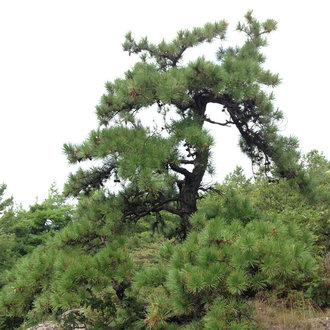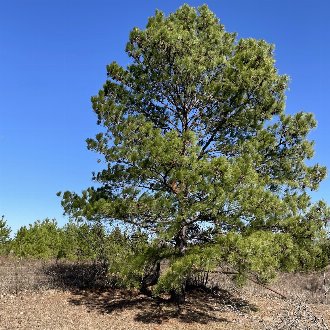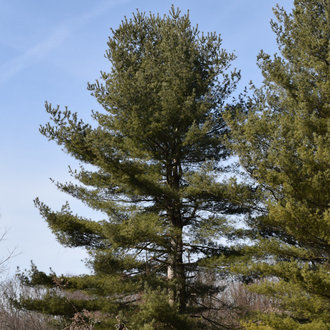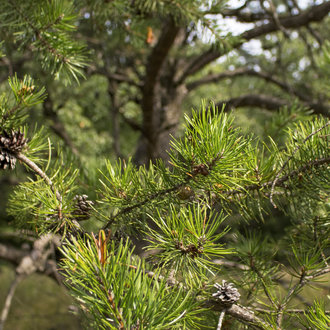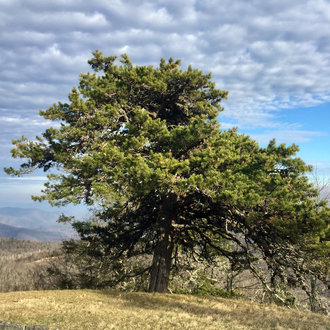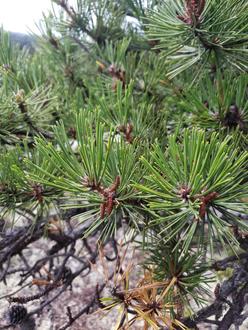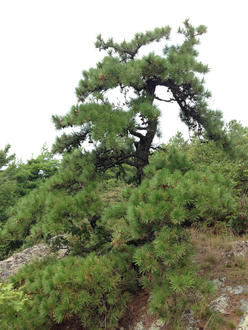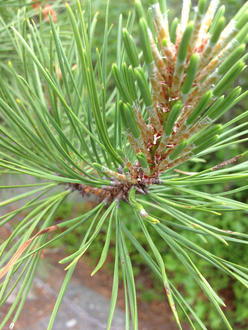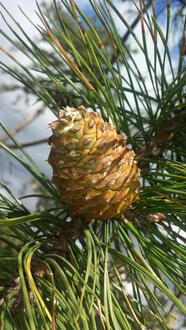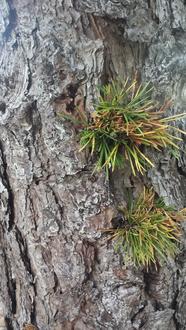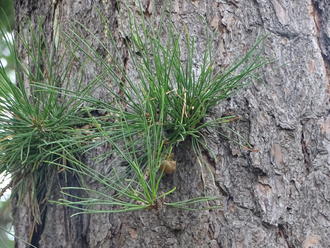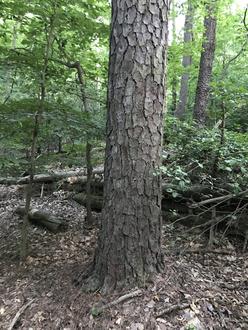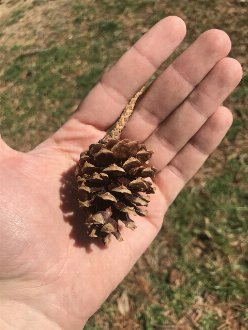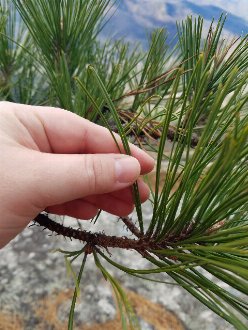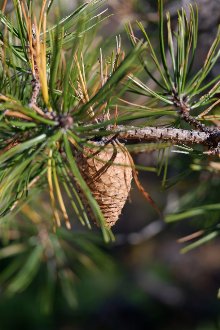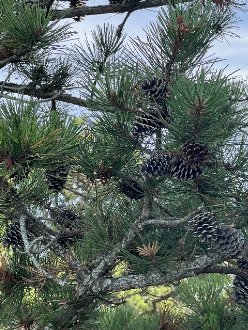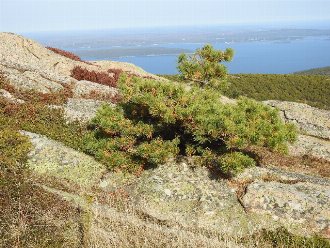Pitch Pine (Pinus rigida Mill.)
↑Summary
A scrubby, fire-adapted pine that often grows in harsh conditions, such as dry, acidic, sandy or rocky soil.
↑Range - Expand
| Legend | Color |
| Introduced or Not Present | |
| Native | |
| Introduced | |
| Native or Introduced |
This tentative map is based on our own research. It may have limited data on Canada and/or Mexico, and there is some subjectivity in our assignment of plants as introduced vs. expanded. Read more in this blog post.
Although this plant occurs somewhere in each of these regions, it may only occur in a small part of some or all of them.
↑Similar Plants
↑Habitat
Pitch pine occurs on a variety of harsh sites, including those with excessively-drained, drought-prone sandy soils, rocky ridges with thin soil, but also in swamps and bogs. It is most common on thin, sandy, or gravely soils that are low in nutrients and poor at holding moisture. It tolerates high aluminum levels in soil, high soil acidity (pH down to 3.4), and soils that have been highly leached of mineral nutrients.
It is highly fire-adapted and frequently found in areas that burn regularly. It can function as a pioneer species in richer and less fire-prone habitats, or a stable climax species on harsher sites. In some areas, such as Martha's Vineyard, it fills an intermediate role in succession, appearing after eastern redcedar but eventually being replaced by other tree species. In the north and at higher elevations, it tends to be replaced by spruces, and in the south and at lower elevations, by various hardwoods.
Pitch pine is highly shade-intolerant and only found on open sites with sufficient direct sunlight.
Pitch pine may have benefitted from human-induced acid rain, as it is more acid tolerant than other species it competes with, and its dominance in habitats is typically limited by competition with other species. However, in other areas, especially coastal areas, fire suppression following European colonization has led pitch pine to be replaced by hardwoods.
↑Life Cycle
Seeds germinate best on exposed mineral soil, but some litter may aid establishment by protecting seeds from predation. Germination is triggered by moisture accompanied by warm temperatures.
Initial growth is slow. After one year, seedlings may only be 0.4 inches on moist sites and half that on drier sites. Growth accelerates as trees reach a foot (0.3m) in height. Growth slows again faster than most pines.
Seedlings that experience flooding during their first year respond by growing additional roots at or above the soil surface, and lenticels on their stems. These responses greatly improve flood resistance as the trees age; older trees not exposed to flooding during their first year are more susceptible to mortality through later flooding. This adaptation may explain this species' presence in swamps and bogs.
Seed production starts very early; trees may produce cones as young as 3 years of age, but more commonly around 10 years. Mature trees produce good seed crops irregularly, at long intervals of 4-9 years. Seed predation is high, perhaps due to the open, exposed conditions in its typical habitat. Some cones open immediately, whereas others are serotinous, remaining closed for years and only opening in response to heat, quickly in response to a fire and more slowly in response to hot, dry weather. Serotinous cone production is highest in areas that burn regularly, but trees in other areas still do produce some serotinous cones.
Pitch pine maintains a seed bank in serotinous cones, but there is little seed banking in soil due to high seed predation.
Unlike most pines, pitch pine is able to resprout both from the root crown and from dormant buds in the bark. These buds are well-protected and can survive lower-intensity fires. Larger, more mature trees typically have thicker bark and are more fire-resistant than younger ones, but trees eventually decline and decrease in resistance and resprouting ability.
Trees on favorable sites may live as long as 200 years, but the harsh habitats that this species is typically found in leads the average lifespan to be much lower, closer to 75 years for most trees that reach maturity.
↑Uses
The wood of pitch pine is sometimes sold, usually mixed with other species and sold as "southern yellow pine", which is mostly used for construction lumber. It has some desirable characteristic, but its high amount of resin can clog tools and sandpaper.
It is not as important as other pine species due to its lower total biomass, reflecting its tendency to be found on harsh sites where it has a stunted growth habit.
Infrequently used in landscaping, where it is valued for its drought resistance and ability to grow on sites where little else will grow, as well as its distinctive form. Can be used as a windbreak on harsh sites.
Has been used with some success to recolonize acidic coal mine spoils, strip-mined land; colonizes these sites on its own if there is a nearby seed source.
Pitch pine has been cited as an excellent source of turpentine.
Native Americans had several uses of this species in traditional medicine, and also used it in construction and carving.
↑Related Plants
Closely related to pond pine (Pinus serotina), which is sometimes considered a subspecies of this one. Pitch pine has a more northerly distribution. The two species overlap towards the end of the pitch pine's range, and hybridize in this zone.
↑Links & External Resources
• Pitch Pine | The Wood Database (About This Site)
• Pitch Pine | Fire Effects Information System (FEIS) (About This Site)
• Pinus rigida (Pitch Pine) | USDA PLANTS Database (About This Site)
• Pinus rigida | Go Botany (About This Site)
• Pitch Pine | Virginia Tech Dendrology Factsheets (About This Site)
• Pitch Pine | Silvics of North America (About This Site)
• Pinus rigida | Biota of North America Project (BONAP) (About This Site)
• Pinus rigida | NatureServe Explorer (About This Site)
• Pinus rigida | Flora of North America (About This Site)
• Pitch Pine | Maryland Biodiversity Project (About This Site)
• Pinus rigida Miller (Pitch Pine) | Digital Atlas of the Virginia Flora (About This Site)



